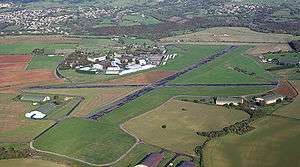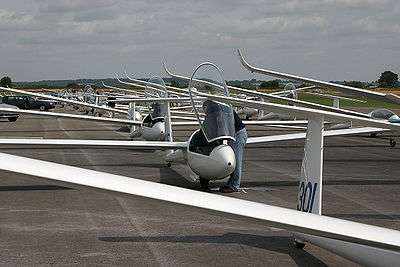Cotswold Gliding Club
The Cotswold Gliding Club (CGC) is based at Aston Down airfield, between Cirencester and Stroud in Gloucestershire, South West England. The club maintains a fleet of aircraft for training purposes, and is a centre for cross-country gliding and competitions.

Club
CGC was formed in 1964. It was initially based at Long Newnton airfield near Tetbury,[1] but in 1967 moved to its current home, Aston Down—at that time still a military airfield. In 1980-1, with the help of Sports Council grants and other loans, the club purchased a large part of the airfield when it was auctioned off by the Ministry of Defence.[2] Having since acquired further land, CGC now owns most of the airfield within the perimeter track.
CGC has some 200 members, including 80 students from the University of the West of England (UWE) in Bristol. There are about 30 associate members: these include both pilots (with limited flying rights) and aeromodellers.[3] In 2007 the CGC widened its membership to include Blokarters.[4]
Airfield

Aston Down is, by gliding standards, a large airfield. The 1500 m main runway (about one mile) offers scope for launches of 450 to 700 m (1,500 to 2,300 ft)—and sometimes up to 900 m (3,000 ft) when the wind direction is straight down the runway. For many years most launches at Aston Down were by the reverse pulley method, but since the year 2000 the principal method of launch has been by winch. The high launches make it easy to contact the abundant thermals that rise from the well-drained Cotswold limestone to give excellent soaring conditions. Aerotow launching is increasingly available, particularly in competitions and when westerly or north-westerly winds generate lift off the Cotswold ridge (or "Edge") or wave lift downwind of the Welsh mountains.
The picture shows Aston Down taken from the south. The main (northeast-southwest) runway runs from bottom left to top right,[5] while the shorter 1,000 m (3,300 ft) east-west runway runs left to right.[6] The disused runway in the distance has been partly removed to allow more room for gliders landing on the grass. Blokarting and aeromodelling are restricted to the runway not currently in use for gliding (which varies according to wind direction).
Club fleet
The club's fleet of aircraft includes two recently acquired modern ASK-21 all-round two-seat training gliders, a DG 500 advanced cross-country trainer which can also be used for aerobatics training, and two ASK-13 two-seat trainers. An ASK-23 is available for early solo pilots, while an Astir provides pilot progression and an ASW-19 is provided for cross-country rated pilots. All Club gliders have similar instrumentation and are equipped with audio variometers.
Gliding activity
The club operates seven days a week during the soaring season (April to September), and on Wednesdays, Fridays and at weekends during the winter months. Members of the public can book trial lessons or more intensive one-day courses,[8] as well as five-day holiday courses.[9] Group flying for work parties, clubs, etc takes place on Tuesday and Thursday evenings in the summer.[10]
In 2008 the club introduced courses specifically designed to give power pilots a hands-on introduction to soaring flight.[11]
Members receive training from the club's 30 BGA-qualified instructors. This training takes pilots to solo and well beyond—to advanced cross-country flying.[12] Privately owned motor gliders based at Aston Down are available for club members for field landing and Cross Country Endorsement checks.[13] During the soaring season many members fly private gliders, usually owned jointly by two or more partners. This flying takes the form of either local soaring or more ambitious cross-country flights, often covering several hundred kilometres. Some examples of recent flights by members of the club can be seen on the BGA Ladder website (2008, the last complete season, and 2009).[14]
Competitions

Aston Down
The excellent runway and facilities available at Aston Down make it a frequent choice for hosting regional and national gliding competitions. As early as 1962 the National Gliding Championships were held at Aston Down under the auspices of the RAF Gliding and Soaring Association,[15][16] with the UK's first ever 300-km task being set.[17] Recent competitions hosted by CGC include the following:
- 2004 Standard Class Nationals (shown on the right)[18]
- 2004 Competition Enterprise[19]
- 2006 15 Metre Nationals
- 2007 Inter University Task Week
- 2008 Club Class Nationals
- 2009 15 Metre Nationals
- 2010 Open Class and Standard Class Nationals
- 2011 Junior Championships
- 2013 Open Class & Standard Class Nationals[20]
- 2015 Junior National Championships and Cotswold Regionals
- 2016 20m Multi-Seat and Standard Class Nationals
- 2017 Standard, Open, 15m & 20m Multi-Seat Nationals
- 2018 Standard, Open & 15m Class Nationals
Other sites
Pilots from Cotswold Gliding Club regularly take part in regional and national competitions, as well as informal competitions such as:
- Rockpolishers League
- An informal group of six local gliding clubs who organize friendly cross-country competitions.[21]
- Two Seater Competition at Pocklington[22]
- In 2007 the club DG 500 and a private Duo Discus from Aston Down took 15th and 5th positions, respectively, out of 33 entrants. In 2011 Duo Discus 572 was placed first in the National two seater championship [23]
- Competition Enterprise
- In 2008 the same two gliders also took part in this competition, which was held at North Hill in Devon.
Other sports
In 2007 Aston Down was the venue for the British Blokart Championships.[24] In July 2008 the Cotswold Cycle Racing League held its final round at Aston Down with a 30 km race comprising six circuits of the airfield.
Facilities
The original control tower houses a briefing room, club room, kitchen and residential accommodation; caravan and camping facilities are also available on site. A large hangar accommodates the club fleet, most of the private gliders owned by club members being stored in trailers or a large, modern back-to-back hangar when not being flown. There is a workshop for maintenance of aircraft, vehicles and winches. The club has recently built its own glider flight simulator to expand the training opportunities for club members.
Notes
- The airfield has long since reverted to farmland. See the history of Long Newnton airfield with photographs of the hangars and parachute store.
- For the dramatic story of this complex auction, in which the airfield was divided into eight lots, see Roberts (1983). This account features horsetrading with a polo club, incognito bidders and a behind-the-scenes agreement by private treaty invoking Crichel Down rules.
- The modellers have been flying their aircraft at Aston Down since 1962—longer than the CGC itself.
- Blokart is a form of land sailing using portable land yachts.
- The CGC webcam monitors the northeastern end of this runway. On most flying days either the launch point (with bus and gliders) or the winch can be seen here.
- In the photograph the main runway appears shorter than the (E-W) cross runway: this foreshortening is due to the angle at which the photograph was taken.
- The bundle on the cable visible on the right of the picture is a parachute designed to retard the fall of the cable after the pilot has released it at the top of the launch.
- See the CGC website for further details on trial lessons Archived 9 October 2007 at the Wayback Machine and one-day courses Archived 9 October 2007 at the Wayback Machine.
- Further details on holiday courses Archived 24 August 2007 at the Wayback Machine.
- See further details on group flying.
- See further details on Gliding For Power Pilots Archived 9 October 2007 at the Wayback Machine
- Cross-country training is undertaken in the club's fibreglass two-seaters: the DG500 and the PW-6Us (which both flew 200-km tasks soon after delivery at Aston Down).
- See the requirements for the UK Cross Country Endorsement (CCE) Archived 22 July 2007 at the Wayback Machine. The CCE is not internationally recognised, but in conjunction with the Bronze C badge is broadly equivalent to a glider pilot's licence.
- Click on any score to see details of the flight (route, distance and pilot's comments). Most flights can also be viewed in 3D in Google Earth by clicking on the KML file link.
- Welch(1980). The date is erroneously given as 1964. The CGC website has a photograph of the competition taken from the air by a pilot on an out-and-return flight from the Long Mynd.
- See the RAFGSA official website
- "Task" is gliding jargon for a set course to be flown on any given day.
- In the clipped terminology of gliding the word "Championship" is usually omitted: hence "Regionals", "Nationals", and even—in defiance of grammar—"a Worlds".
- Competition Enterprise Archived 2008-08-28 at the Wayback Machine is an informal competition started in 1974 with the aim of "bring[ing] back the fun to competitive flying".
- Competition website can be found at www.cotswoldgliding.co.uk/comps Archived 2011-07-15 at the Wayback Machine
- The other clubs are: Nympsfield, Usk, Talgarth, Shobdon and Long Mynd. See this account of the 2007 Rockpolishers Archived 2012-09-04 at Archive.today.
- The Pocklington Two Seater Competition is a comparatively relaxed event, set up in the 1980s as an antidote to what were seen as excessively "serious and steely eyed" regional and national competitions. It gives aspiring cross-country pilots the opportunity to improve by flying with more experienced pilots.
- Rob Jewell. "Blokart Nationals at the Cotswold Gliding Centre (sic), Stroud". Yachts and Yachting Online Ltd. Retrieved 13 November 2007.
References
Roberts, David (August–September 1983). "The battle for Aston Down". Sailplane & Gliding. XXXIV (4): 160–2.
Welch, Ann (1980). The Story of Gliding (2nd ed.). London: John Murray. p. 173. ISBN 0-7195-3659-6.
External links
- Cotswold Gliding Club Official website

- UWE Gliding Club
- Cotswold Radio Control Society (modellers)
- Blokarters UK
